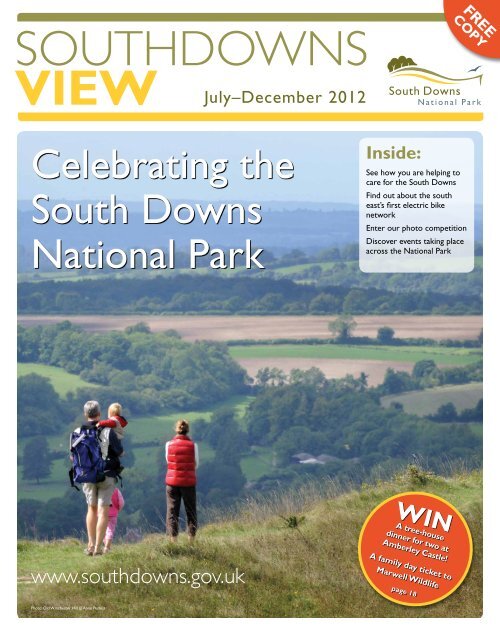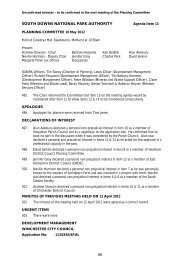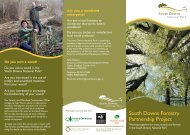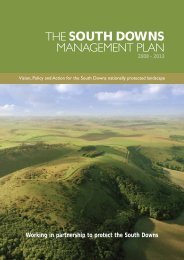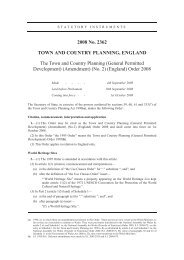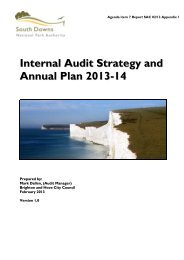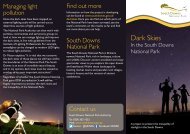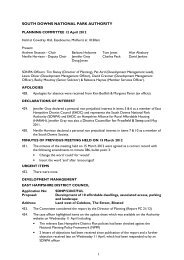South Downs View - South Downs National Park Authority
South Downs View - South Downs National Park Authority
South Downs View - South Downs National Park Authority
- No tags were found...
Create successful ePaper yourself
Turn your PDF publications into a flip-book with our unique Google optimized e-Paper software.
Information<strong>South</strong> <strong>Downs</strong> <strong>National</strong><strong>Park</strong> <strong>Authority</strong>Photo competition: Can you captureLife in our Landscapes?The <strong>South</strong> <strong>Downs</strong> <strong>National</strong> <strong>Park</strong> uniquely combines a biodiverselandscapes with bustling towns and villages, covers an area of over1,600 km 2 , is home to more than 110,400 people and is Britain’snewest national park.The <strong>South</strong> <strong>Downs</strong> <strong>National</strong> <strong>Park</strong> <strong>Authority</strong> (SDNPA) is theorganisation responsible for promoting the purposes of the <strong>National</strong><strong>Park</strong> and the interests of the people who live and work within it.Our purposes are:1. To conserve and enhance the natural beauty, wildlife and culturalheritage of the area.2. To promote opportunities for the understanding and enjoyment ofthe special qualities of the <strong>Park</strong> by the public.Our duty is to work in partnership to seek to foster the economicand social well-being of the local communities within the <strong>National</strong><strong>Park</strong>.You can contact the <strong>South</strong> <strong>Downs</strong> <strong>National</strong> <strong>Park</strong> <strong>Authority</strong> at:Rosemary’s Parlour, North Street, Midhurst, West Sussex GU29 9SBTel: 0300 303 1053Email: info@southdowns.gov.ukwww.southdowns.gov.ukLast year’s winning photo of the Cuckmere by Chris MoleWINThis year we’re challenging you to capturean image showing how people work, live inand enjoy the <strong>South</strong> <strong>Downs</strong> <strong>National</strong> <strong>Park</strong>.Whether you want to tellza story, highlightthe challenges created when people andnature come together or simply focus onpeople enjoying the scenery, we want to seeyour best photos.Over the centuries farmers haveshaped and cared for our landscapes,bustling market towns have influenced ourarchitecture and today paragliders drifteffortlessly above us. The <strong>National</strong> <strong>Park</strong> is famous for its beautiful landscapes£150 and other fantasticprizes and your image willfeature in the next issue of<strong>South</strong> <strong>Downs</strong> <strong>View</strong>and is home to around 110,000 people with millions more visiting and enjoyingit every year. We want to see your best shots of when people and landscapecome together.If your photo is chosen by our panel, you will win £150 in vouchers tospend at Petersfield Photographic, a year’s subscription to Outdoor Photographymagazine, a day of landscape photography training with photographer SimonParsons and your image will feature in the next issue of <strong>South</strong> <strong>Downs</strong> <strong>View</strong>.The deadline is 15 October 2012. How to enter, as well as terms andconditions, can be found at www.southdowns.gov.uk/photocomp20122south downs <strong>View</strong>www.southdowns.gov.uk
WelcomeWelcome to thissecond newsletterfrom the <strong>South</strong><strong>Downs</strong> <strong>National</strong> <strong>Park</strong><strong>Authority</strong>Since we became operationaljust over a year ago we andour partners have been verybusy improving the <strong>South</strong><strong>Downs</strong> <strong>National</strong> <strong>Park</strong>. Itis early days yet but thisnewsletter gives you a flavourof what is being achieved andwhat is planned.15 July marks the 40th anniversaryof the <strong>South</strong> <strong>Downs</strong> Way. The creationof this iconic <strong>National</strong> Trail was asign of things to come and today itforms the spine of the <strong>South</strong> <strong>Downs</strong><strong>National</strong> <strong>Park</strong>, running all the wayfrom Winchester to Eastbourne. Youcan read more about the anniversaryof the <strong>South</strong> <strong>Downs</strong> Way on page 17.On pages 4–5 you can read allabout our exciting new <strong>South</strong> <strong>Downs</strong>Way Ahead project. Again using the<strong>South</strong> <strong>Downs</strong> Way as its spine, theproject is one of 12 trailblazing NatureImprovement Areas (NIAs). Led bythe <strong>National</strong> <strong>Park</strong> <strong>Authority</strong>, this £3million project has received a grantof £608,000 in Government fundingand brings together 29 partners fromacross the <strong>South</strong> <strong>Downs</strong> <strong>National</strong><strong>Park</strong> (including the <strong>Authority</strong>) andbeyond to restore and protect rarechalk downland.Such partnership working is atthe heart of how the <strong>South</strong> <strong>Downs</strong><strong>National</strong> <strong>Park</strong> <strong>Authority</strong> works andis integral to the <strong>National</strong> <strong>Park</strong>’ssustainable future.We have also worked with partnersand stakeholders from across the<strong>South</strong> <strong>Downs</strong> and beyond to developthe special qualities of the <strong>National</strong><strong>Park</strong>, a State of the <strong>Park</strong> report and a30-year vision for the <strong>National</strong> <strong>Park</strong>.This vision will guide us as we developour strategic Management Plan and ourfirst Core Planning Strategy.We hope you will join us in becomingactively involved and, above all, caringfor this unique and wonderful place. Inthe following pages you will find lotsof opportunities for getting involvedand having fun. Our online Forumis also a great place to stay in touchwith debates and have your say aboutthe multitude of issues affecting the<strong>National</strong> <strong>Park</strong> http://southdownsforum.ning.com/main.Margaret ParenChair of <strong>South</strong> <strong>Downs</strong> <strong>National</strong> <strong>Park</strong><strong>Authority</strong>This is the first edition of<strong>South</strong> <strong>Downs</strong> <strong>View</strong> to beproduced since I became ChiefExecutive of the <strong>National</strong> <strong>Park</strong><strong>Authority</strong> in January. I think itcaptures the breadth of ourwork and our wide range ofpartners – led by the localauthorities and parishes – whowork with us to conserve,enhance and celebrate ourvery special <strong>National</strong> <strong>Park</strong>.There are many examples of theseactive partnerships in the pages whichfollow, such as the Our <strong>South</strong> <strong>Downs</strong>project, which works with 738 localschools to encourage children tomap and explore the world on theirdoorstep, and the launch of the southeast’s first electric bicycle network.The <strong>Authority</strong> has also joined thepartnership bidding to UNESCO forinternational recognition for parts ofthe <strong>National</strong> <strong>Park</strong> surrounding Brightonand Hove and Lewes, including the cityof Brighton and Hove itself.A distinctive feature of our <strong>National</strong><strong>Park</strong> is the central importance of itsdedicated volunteers. There are manydescriptions of their work in thisedition, such as the shepherd’s caravanthat has been restored through sixmonths hard work by a team of some20 volunteers. The caravan, which wasthe centre of attention on our standat the rain sodden <strong>South</strong> of EnglandShow, is an imaginative project thatneatly symbolises the rich social andagricultural history of the <strong>South</strong> <strong>Downs</strong>.One of the great things about my jobis the chance to see at first hand thepositive impact that the <strong>National</strong> <strong>Park</strong> ishaving on the landscape and wildlife ofCOLLABOR8COLLABOR8, an EU (Interreg IVb)funded project, has contributed tothe production of this newspaper.The funding, which runs until 2012,supports local businesses to developthe <strong>South</strong> <strong>Downs</strong>. For instance, I spentan enjoyable afternoon in late Maytracking down the rare Pearl-borderedFritillary in an area of coppicingnewly established by our rangers andthe landowner. It was ideal butterflyweather and their bright orange wingsand swooping flight made them easyto spot. We counted 17 in a singlewalk across the site, which is a goodsign for the future.This strengthening of local butterflypopulations encapsulates the missionof the <strong>National</strong> <strong>Park</strong> <strong>Authority</strong> –carefully targeted work in line withnature and in association with localauthorities, land managers, partnersand volunteers that generates ameasurable improvement in thelandscape and its wildlife. You can reada lot more about this in the pageswhich follow.Trevor BeattieChief Executiveinnovative sustainable visitor productsand services across the <strong>South</strong> <strong>Downs</strong>.Now that the <strong>South</strong> <strong>Downs</strong> is a<strong>National</strong> <strong>Park</strong>, it is vital that businessesare ready to embrace opportunities -but as a sustainable visitor destination,benefiting the communities, businessesand environment alike. Featuresthroughout the newspaper illustratehow this can be achieved. To find outmore visit www.southdowns.gov.uk/collabor8.www.southdowns.gov.uk south downs <strong>View</strong> 3
partnership workingDownland slopes near Sullington © Anne PurkissWorking together to saveprecious chalk downlandEarlier this year we announceda new partnership, whichbrings together farmers,conservationists, nongovernmentalorganisations(NGOs), community groups,government bodies, researchorganisations and watercompanies, for a new £3million pound project, knownas <strong>South</strong> <strong>Downs</strong> Way Ahead.The partnership consists of 29organisations working together tosafeguard endangered chalk downlandin the <strong>South</strong> <strong>Downs</strong> area while alsoconnecting local communities with thelandscape. The project was selectedas one of 12 trailblazing projects topioneer the Government’s new NatureImprovement Area (NIA) scheme. Indoing so it has been awarded £608,000in government funding from theSecretary of State for the Environment.Supported by the Departmentfor Environment, Food and RuralAffairs (DEFRA), the Department forCommunities and Local Government,the Environment Agency, the ForestryCommission and Natural England, theNIA scheme will operate over threeyears from 2012 to 2015. Each ofthe chosen 12 NIA schemes coversa different landscape, from the urbanareas of Birmingham and the BlackCountry to the rivers and woods ofNorth Devon, as well as our own chalkdownland.Only an estimated 4% of the totalarea of the <strong>National</strong> <strong>Park</strong> is pristinechalk download and it is recognisedinternationally as an important andendangered habitat. Not only is chalkdownland vital to the survival of rareand endangered wildlife it is also reliedon by millions of people in the areato provide clean drinking water and avaluable green space. However, theseareas are fragmented and the speciesProtecting the Duke ofBurgundy butterflyGreyfriars Farm in Storrington has been workingwith the <strong>South</strong> <strong>Downs</strong> <strong>National</strong> <strong>Park</strong> <strong>Authority</strong>and Butterfly Conservation on a project toencourage the spread of threatened chalkdownland species, such as the rare Duke ofBurgundy butterfly.“Through working in partnership with the<strong>National</strong> <strong>Park</strong> and conservationists we have beenable to introduce new methods of grasslandmanagement to our land in order to create anenvironment to help butterfly species colonise thearea,” says Mark of Greyfriars Farm.supported are increasingly under threatdue to the decreasing size and isolationof habitats.“Chalk downland is often referred toas the European equivalent of tropicalrainforest because its wildlife is sorich and diverse,” says Emily Brennan,Biodiversity Strategy Lead at the <strong>South</strong><strong>Downs</strong> <strong>National</strong> <strong>Park</strong> <strong>Authority</strong>. “TheNIA project aims to enhance, expandand reconnect these separated areas ofchalk grassland in the <strong>South</strong><strong>Downs</strong> through workingwith local landowners andcommunities.”Neil Hulme of ButterflyConservation comments: “Chalkdownland managed in a particularway is vital for the survival of rarespecies such as the Duke of Burgundybutterfly. Numbers on the <strong>South</strong> <strong>Downs</strong> havebeen in decline for decades but small andisolated populations still survive, and we hopeto encourage their spread along the escarpmentbetween Chantry Farm at Storrington andChanctonbury Ring.The level of co-operation between so manydiverse parties has been amazing. Through workingtogether we have been able to identify the precisehabitat requirements of the Duke of Burgundyand deliver focused efforts to meet its particularneeds.”The project will cover a onekilometre wide corridor along the lineof the <strong>South</strong> <strong>Downs</strong> Way <strong>National</strong>Trail, concentrating on five focal areas:Winchester, Harting and Midhurst,Worthing, Brighton, Hove and Lewes,and Eastbourne. The project will extendinto the urban area of Brighton andHove via its Green Network. The <strong>South</strong><strong>Downs</strong> Way trail naturally follows theline of the iconic chalk downland scarpand links 19 chalk grassland Sites ofSpecial Scientific Interest (SSSIs), whichare nationally protected sites. In total,the extensive project will cover an areaof just under 42,000 hectares.At Greyfriars Farm, itwas decided that thebest course of actionwas to introducecattle grazing tocertain areas of land.”Mark explains: “Unlike sheep, the grazingaction of our cattle creates a better environmentfor some types of butterfly, enabling them toreconnect and thrive. Meanwhile in other areas wehave worked to control invasive scrub.”Where the habitat management is right itis remarkable how rapidly populations canbuild,” adds Neil. “There are also many otherbeneficiaries of this type of work, including otheruncommon species such as the Dingy Skipperbutterfly and numerous downland plants.”4south downs <strong>View</strong>www.southdowns.gov.ukSt. Catherine’s Hill, Winchester (Courtesy of Winchester
partnership workingSt Caths ShepherdingWinchester Conservation Skills ProjectPhoto © Dave RumbleThe <strong>South</strong> <strong>Downs</strong> Way Ahead partnership aims to work with local communities to reconnect themwith their surrounding landscape and encourage them to take an active role in restoring chalk grassland.One such engagement scheme is the Winchester Conservation Skills Project. Managed by theHampshire and Isle of Wight Wildlife Trust, the initiative helps set up local volunteer groups and trainsthem to carry out valuable conservation work in the River Itchen area.David Rumble of the Hampshire and Isle of Wight Wildlife Trust explains: “We aim to educate andsupport volunteers in all areas of conservation, from traditional countryside skills, like coppicing, hedgelaying and fencing to livestock welfare checking ‘lookering’, scrub management and the maintenance ofhistorical structures.”As well as providing an opportunity to learn new skills, the scheme aims to help people from urbancommunities to understand, value and feel more confident about accessing the landscape.The volunteers also make a vital contribution to work carried out by organisations like the Trust.“The work of our volunteers has helped to secure the future of many precious habitats and species,such as the <strong>South</strong>ern Damselfly, Water Vole and Chalk Hill Blue Butterfly, enabling them to thrive again,”comments David.Anyone can volunteer to be involved in the scheme, which is due to start this summer. For moreinformation please visit www.hwt.org.ukWater © Pete CurrellImproving groundwaterqualityThere are 1.2 million people living in andaround the <strong>National</strong> <strong>Park</strong> that depend on waterfiltered through and stored in the <strong>South</strong> <strong>Downs</strong>chalk downland, but several of our groundwatercatchments are suffering from poor water quality.The <strong>South</strong> <strong>Downs</strong> Way Ahead project willsupport farmers and water companies to worktogether to identify and target land managementactivity to improve groundwater quality, forexample, by restoring wetland and chalk grasslandhabitats or by growing specific crops.“Many people in the area do not realise thatthe water they are drinking comes from the chalkdownland around us,” says Sean Ashworth fromthe Environment Agency. “Through the <strong>South</strong><strong>Downs</strong> Way Ahead partnership we hope toengage with local communities about how we canwork together to look after our groundwater.”The Environment Agency is already workingclosely with local farmers and landowners acrossthe <strong>National</strong> <strong>Park</strong> to offer advice on effectiveland management and practices that won’t havea negative effect on groundwater; the <strong>South</strong><strong>Downs</strong> Way Ahead project will build on thiswork. “By using sensitive management techniquesand getting good advice on fuel storage and farmrun off where it’s needed, we can help improvethe groundwater in the area,” explains Sean.Groundwater quality monitoring alreadyundertaken regularly by the Environment Agencyand water companies will be used to measure theproject’s success.A spring at FulkingThe main objectives of the <strong>South</strong><strong>Downs</strong> Way Ahead project are to:• restore and enhance chalk downlandfor endangered species and habitats.• improve water quality throughappropriate land management.• encourage communities to takean active role in looking after thelandscape.Each part of the project will involvedifferent organisations from within thepartnership working together to createa more joined-up habitat.The <strong>South</strong> <strong>Downs</strong> <strong>National</strong> <strong>Park</strong><strong>Authority</strong> is leading the partnership,spearheaded by members of the teamsuch as Area Manager, Nigel James, whocomments: “The success of landscapescaleprojects such as the <strong>South</strong><strong>Downs</strong> Way Ahead NIA is completelydependent on a wide range of partnersworking together to achieve a commonvision. The depth and breadth of thepartnership shows the high level ofenthusiasm and commitment that thesepartners have to achieve the commonvision of restoring and reconnecting thechalk habitats of the <strong>South</strong> <strong>Downs</strong>.”As well as bringing together partnerorganisations, the project also aims toconnect with the wider community ofpeople living in and around the <strong>South</strong><strong>Downs</strong> <strong>National</strong> <strong>Park</strong>. New engagementinitiatives have been developed toeducate and inspire local communitiesto take an active role in helping torestore and conserve the landscape inwhich they live.NIA PartnersThe NIA is made up of a partnership of 29 organisations from across the <strong>South</strong><strong>Downs</strong> <strong>National</strong> <strong>Park</strong>. The partners are:Arun and Rother Rivers Trust(ARRT), Brighton and Hove CityCouncil, Butterfly Conservation,Environment Agency, EastbourneBorough Council, Forest Research,Games & Wildlife Conservation Trust,Hampshire Biodiversity InformationCentre (Hbic), Hampshire & Isle ofWight Wildlife Trust, Kew Wakehurst,University of Leeds, Lewes & OuseValley eco-nomics, Lewes DistrictCouncil, <strong>National</strong> Trust, NaturalEngland, Portsmouth Water,Rural Economy and Land UseProgramme (relu), RSPB, SussexBiodiversity Record Centre, <strong>South</strong><strong>Downs</strong> Land Management Group,<strong>South</strong> <strong>Downs</strong> Network, <strong>South</strong> <strong>Downs</strong><strong>National</strong> <strong>Park</strong> <strong>Authority</strong>, <strong>South</strong> <strong>Downs</strong>Society, <strong>South</strong> East Water, <strong>South</strong>ernWater, Sussex Wildlife Trust, SteyningDownland Scheme, University ofBrighton, Winchester City Councilwww.southdowns.gov.uk south downs <strong>View</strong> 5
cultural heritageAn insight into the churchesof the <strong>South</strong> <strong>Downs</strong>Over the past three yearsa pilot study undertakenby volunteers has beeninvestigating churches withina concentrated area of the<strong>South</strong> <strong>Downs</strong> <strong>National</strong> <strong>Park</strong>in Hampshire. The aim is tounearth common stories thatconnect certain churchesand eventually producelandscape scale guides topromote understanding of thecollective impact and historicalsignificance of these churches.The survey involves preliminaryweb-based background workfollowed by a biodiversity survey andinvestigations into the architectural andcultural aspects of the church and itssurrounding area, to establish a greaterunderstanding of its place within thelandscape. The survey also looks intokey characteristics of each church todiscover its unique special qualities.A good example is the historyof William Nicholson, a wealthylandowner of Basing <strong>Park</strong>, who owneda gin factory and built the sizeablecathedral-like Privett Church to occupyhis workers. Nicholson also put hisstamp on the landscape in other ways;it was discovered that he built his ownpersonal railway station that divertedSt Mary’s Church, Friston© R. Reedfrom the Meon Valley Railway. An avidcricket fan, it is said he also steppedin to save Lord’s Cricket Ground andinterestingly, the logo of the cricket clubhas the same colours as that of his ginfactory.It is hoped that in due course theproject will be extended to otherparishes within the <strong>National</strong> <strong>Park</strong>.An archaeological project for allIn the heart of the <strong>South</strong> <strong>Downs</strong> <strong>National</strong> <strong>Park</strong> lies a sitebetween the villages of Liss and Colemore in Hampshirethat is rich with historic significance. It is here that the LissArchaeological Group (LAG) plans to stage a 3–5 yeararchaeological study to involve the local community, both youngand old.The first community archaeologicalstudy organised by LAG took placebetween 2005 and 2010 in West Liss.Since the completion of that project,a second, previously unknown Romansettlement based near Colemorenearly 2000 years ago was discoveredand the first excavation took place inthe autumn of 2011 following severalyears of geophysical surveys and testpits. The local community were invitedto take part in the dig and in doingso they picked up valuable new skills.Donating around 500 days in total, 49volunteers took part aged from 7 upto 70.The 2011 study stirred up a greatlevel of interest among the surroundingcommunity and provided the childrenof Ropley School with a fascinatingopportunity to handle some of theRomano-British finds and to take partin some archaeological activities.Focusing on the recently discoveredRomano-British settlement, the latestproject will extend across a widerarea around the villages of Colemore,Hawkley, Froxfield and Liss.The new project will providean excellent opportunity to usetechniques such as field walking, aerialphotography, and geophysics to furtherLAG members at work© Juliet Lewisinvolve the community and localschools.Juliet Smith, Archaeological Directorof LAG, commented: “As a group, itis important to us that the wholecommunity is involved as it is theirheritage that we are investigating.Archaeology is an exciting pastimethat offers something for everyone.And most importantly, we all have athoroughly enjoyable time in the freshair and beautiful scenery of the <strong>South</strong><strong>Downs</strong> <strong>National</strong> <strong>Park</strong>.”LAG welcomes new members. Formore information visit their website:www.lissarchaeologicalgroup.org.uk© R. SaundersExcavation of the Sterling Bomber near Lurgashall6south downs <strong>View</strong>Stirling bomber uncovered in the <strong>South</strong> <strong>Downs</strong><strong>National</strong> <strong>Park</strong>On the evening of 4–5 May 1942, a Stirling aircraftR9313, of 218 Squadron, was shot down by ‘friendlyfire’ when it was mistaken for a German plane. Theplane, which had been returning from a raid to droppropaganda leaflets over German occupied territory,crashed into a field near Lurgashall in West Sussex.The R9313 debris is significant as no Stirling bombers remainanywhere in the world and there are no plans in existenceshowing the design of the aircraft. However, the remains of theWest Sussex crash will help to further an ongoing specialistproject that aims to re-create the historic plane.Immediately following the 1942 crash an RAF MaintenanceUnit cleared away surface wreckage and it is likely that localsouvenir hunters at the time would have picked up anythinginteresting that had been left behind. In 1977, excavation workwas carried out to uncover more of the aircraft but recentsurvey work showed that there was still part of the planeburied deep underground.In January 2012 a group of archaeologists and a TVproduction company came to the <strong>South</strong> <strong>Downs</strong> to revisitthe site of the crash. They were also joined by a number ofservicemen from Operation Nightingale, an army project whichuses archaeology to help rehabilitate injured soldiers.The team hope that their new excavation work will help tofaithfully replicate a Stirling bomber and discover more aboutthe events that led to the crash. They are also hoping to findout whether any of the propaganda leaflets from the missionhad survived.The results will be reported in a special programme on theHistory Channel this summer and will help to reveal moreabout the recent history of the <strong>South</strong> <strong>Downs</strong> <strong>National</strong> <strong>Park</strong>.www.southdowns.gov.uk
Local CommunitiesSupporting community projectsBreaking ground for the new visitors centre at Butser Ancient FarmA road show teaching childrenabout sustainable transport, anew visitor centre and lessonsin woodland skills, these arejust some of the projects thathave been achieved in thelast year with help from theSustainable Communities Fund(SCF).What is the SustainableCommunities Fund?The SCF is a £700,000 fund, which wasintroduced in 2011 for community,voluntary and not-for-profit groups ororganisations that need funding for aproject within the <strong>National</strong> <strong>Park</strong>.In order to be eligible for thefund, the projects must in some wayconserve and enhance the naturalbeauty, wildlife or cultural heritageof the <strong>National</strong> <strong>Park</strong> and its specialqualities while also demonstratingcommunity involvement, and promotingopportunities for the understanding andenjoyment of the <strong>National</strong> <strong>Park</strong> by thepublic. It is also essential that projectsare sustainable and can develop tobecome financially independent overtime.Already £400,000 has beencommitted to 57 diverse local projects,which has been used in a great manyways, from helping with start-up costs,renovations and research to purchasingequipment, conservation work andtraining.Funding is also available toorganisations located outside of the<strong>National</strong> <strong>Park</strong> boundary as long as theproject demonstrates a clear link toenhancing and conserving the <strong>National</strong><strong>Park</strong> area.How much can beapplied for?Organisers can apply for up to 60%of the total cost of a project, from£250 up to the maximum of £20,000.Take a spinaround the<strong>South</strong> <strong>Downs</strong>The <strong>South</strong> East’s first Electric BicycleNetwork has been launched in the<strong>South</strong> <strong>Downs</strong>, giving visitors theopportunity to hire and ride electricbikes (ebikes) around the rural lanesand trails of the <strong>National</strong> <strong>Park</strong>.The ebikes offer a sustainable new way ofdiscovering the beauty of the <strong>South</strong> <strong>Downs</strong>and are designed to do the hard work, enablingyou to completely appreciate the stunninglandscape and enjoy the simple pleasure ofcycling in the great outdoors.The scheme currently has a fleet of tenbikes, which are available to hire at Alice HoltForest Centre, Petersfield, Alton and Midhurst.The remaining 40% can includeinvestment from your own organisation,other grants or contributions, andcontributions in kind such as volunteertime or materials.There are certain organisations andprojects that are not eligible for funding,a list of these can be found on ourwebsite.How to apply?An application pack can be downloadedfrom our website at www.southdowns.Our own Area Manager Nick Heasman (centre) tests the new electric bikesRiders can stop and recharge their batteries at13 local charge points whilst enjoying a bite toeat, a drink or a local attraction. Charge pointsinclude Jane Austen’s House Museum, StanstedHouse and The Rural Life Centre at Farnham,as well as a selection of picturesque villagepubs.gov.uk or you can call the team directlyon 01730 811755 for a pack to besent out to you. We strongly advisethat anyone considering applying fora grant contacts our External FundingCoordinator to talk through a proposal.To find out more about the SCFand grant conditions, or to downloadan application pack please visit: www.southdowns.gov.uk/communities/funding/applying-for-funding.For the full list ofhire and charge points,as well as informationon how to book bikes,please visit: www.electricbicyclenetwork.com© Chris Pearsall Photography8south downs <strong>View</strong>www.southdowns.gov.uk
Local CommunitiesIndustrial heritage inCoultershawCoultershaw Heritage site givesvisitors an insight into how theindustrial revolution affected therural landscape within the <strong>National</strong><strong>Park</strong>. Home to a working beam pump,installed in 1782 to pump water fromthe River Rother up to Petworth, thesite also has interactive water pumps,an original engine house and mill pond.The Sustainable Communities Fundis supporting Coultershaw Trust’s bidfor Heritage Lottery Funding with acontribution of £20,000 to help themimprove sustainable public access tothe site.Butser Ancient Farmgets a new visitorcentreButser Ancient Farm is an experimentalarchaeological research site that isopen to the public, with reconstructedroundhouses and a Roman villa atBascomb Copse, near the village ofChalton, in the <strong>National</strong> <strong>Park</strong>.This well established rural educationcentre attracts 15,000 children onschool trips and 10,000 membersof the public each year and aims toprovide visitors with an exciting, handson insight into the lives of the Celts andRomans in ancient Britain.The £30,000 SCF grant willgo towards building a new visitorcentre. The eco-friendly buildingwill incorporate a toilet block,office, visitor facilities, staff roomand education area where artifactsand photos of the farm can bedisplayed. The project, which isdue to be finished this autumn, willuse sustainable technologies suchas rainwater filtration and storagetanks, modern, low-water usage toiletsystems, waterless urinals and energyefficient hand dryers. Building materialswill also be sourced locally.Saddlescombe Farmwelcomes backpackersSaddlescombe Farm is a <strong>National</strong> Trustsite nestled in a hamlet near Devil’sDyke on the <strong>South</strong> <strong>Downs</strong> Way.An environmentally friendly planhas been developed focusing onusers of the <strong>South</strong> <strong>Downs</strong> Way andemphasises Saddlescombe as a carfreesite. The project received £16,999from the SCF to develop a back-tobasicscampsite for backpackers, whichcan only be reached by foot, as well asa Hiker’s Rest tea-room and new toiletfacilities.The site for the new toiletsAll aboard at theShipwrights WayThe ship is completedThe SCF has recently helped support aproject to create a children’s play shipto encourage visitors to make use ofthe Shipwrights Way, a long-distancewalking and cycle route starting inAlice Holt Forest, Hampshire andextending to Portsmouth HistoricDockyard.The ship, which measures 11x3metres, was built by the ForestryCommission using locally andsustainably sourced softwoodtimber and is situated in a play areaadjacent to the Shipwrights Way route.“We wouldn’t have been ableto build the play ship without thesupport from the SCF’, explains JulianWilliams of the Forestry Commission.“It is fantastic to see so many childrenenjoying the new addition to theplay park, which also has a strongconnection to our local shipbuildinghistory.”Smarter ChoicesRoadshow comes tothe <strong>South</strong> <strong>Downs</strong>Smarter Choices road show at Greatham School, HantsFollowing a successful pilot project in2010, the Smarter Choices Roadshowreceived a grant of £27,000 from theSCF to visit 60 schools and 12,000students during 2011/12.The roadshows help to engagestudents about the benefits ofusing sustainable transport, fromenvironmental to financial to healthbenefits.Using an exhibition unit andinteractive resources such as electriccycles and electric motor scooters,pupils can experience first-hand theexciting new forms of sustainabletransport.Terry Osborne, OperationsDirector for the roadshow said:‘We try to put a serious messageNeighbourhood planningThe <strong>South</strong> <strong>Downs</strong> <strong>National</strong> <strong>Park</strong><strong>Authority</strong> is now working withlocal communities to help with theintroduction of neighbourhoodplanning. This is a new rightintroduced through the Localism Act2011 giving people more power inshaping development and growth intheir town or parish.Tim Slaney, Director of Planningat the SDNPA, says, “We believestrongly in helping local communities.For the first time plans drawn upby local residents, businesses, parishcouncils and civic leaders will havereal teeth in the planning world and asay in where local development takesplace. Larger more strategic planpolicy making and planning decisionsacross in an informative, realistic andentertaining way regardless of the ageof the pupils we are visiting. We wereobviously delighted that the roadshowreceived 100% positive feedback fromall the schools that we visited.’Learning new skills inQueensdown WoodsThe Sustainable Communities Fundhas recently helped launch a project inQueensdown Woods, near Brighton,East Sussex involving a series of eventsteaching 150 local residents, schoolchildren and volunteers, valuablewoodland skills.The events gave participants theopportunity to learn new skills incoppicing, conservation and theclearance of invasive species, to helpmanage and enhance woodland areas.“After successfully campaigning forthe woods to be part of the <strong>National</strong><strong>Park</strong>, we wanted to host a diverseprogramme of events that wouldattract a wide range of people, many ofwhom may not otherwise access thewoodland”, explains Warren Carterfrom Moulsecoomb Forest Gardenand Wildlife Project. “The workshopsare an effective way of highlighting thefantastic resource that is on people’sdoorstep.”A new series of woodland skillslessons is currently being planned for2012/13.will continue to be taken by planningauthorities such as the <strong>National</strong><strong>Park</strong>.”As of 1 June 2012 three parishcouncil’s within the <strong>National</strong> <strong>Park</strong> andfive on its borders had come forwardas ‘front runner’ projects which willhelp the Government test the newsystem. The SDNPA is supportingthese communities and will havea big role as the plans develop, forexample in organising independentexaminations of the plans.More information onneighbourhood planning in the<strong>South</strong> <strong>Downs</strong> <strong>National</strong> <strong>Park</strong> is atwww.southdowns.gov.uk/planning/neighbourhood-planning.www.southdowns.gov.uk south downs <strong>View</strong> 9
eventful downsEventful <strong>Downs</strong>Your guide to events across the<strong>South</strong> <strong>Downs</strong>For full details of these and many more events, visit our website atwww.southdowns.gov.uk/enjoying/events.Events with are those where <strong>South</strong> <strong>Downs</strong> <strong>National</strong> <strong>Park</strong> <strong>Authority</strong> are exhibiting.See the ‘events’ page on our website for more details.July2 July 10am–4pmPropagation, Planting and PruningGilbert White’s House and Garden, Selborne,Hampshirewww.gilbertwhiteshouse.org.uk 01420 511274Limited bus service to/from Selborne4 July 7.30pmRomeo and JulietPicnic TheatreCowdray Heritage Trust, Midhurst, W. Sussexwww.cowdray.org.uk 01730 810781By Bus: buses from Chichester, Petersfield,Haslemere and PetworthBy Rail: nearest station is Haslemere (9 milesdistance)14–15 JulyPirates and Smugglers’ WeekendArundel Castle, Arundel, W. Sussexwww.arundelcastle.org 01903 882173Arundel rail station nearby15 July Afternoon EventBinsted Strawberry FairBinsted, West Sussex15 July 11am–1pmHeather, Dragons and Tigers!RSPB Pulborough Brooks Nature Reserve,Wiggonholt,W. Sussexwww.rspb.org.uk/pulboroughbrooks 01798875851100 Bus from Pulborough Station27–29 July 10.30am–5pmGarden Event- Chilli FestivalWest Dean Gardens, West Dean College, WestDean, W. Sussexwww.westdean.org.uk 01243 818314Bus no. 60 from Chichester28–29 July 10am–4pmWood Carving CompetitionButser Ancient Farm, Chalton, Hampshirewww.butserancientfarm.co.uk 02392 598838Buses: 38 from Petersfield; half mile walkAugust1 August 2.30–4pmReptile SafariIping Common Car parkFor more information call Bruce Middleton on01730 817945.1 August 8–10pmBats at SlindonSlindon Estate, Slindon, W. Sussexwww.nationaltrust.org.uk/<strong>South</strong><strong>Downs</strong>01243 8147302–5 August 10.30am–5pmSussex Guild Contemporary ShowMichelham Priory, Hailsham, E. Sussexwww.sussexpast.co.uk 01323 8442243 August 10am–12 noonWild About PlantsRSPB Pulborough Brooks Nature Reserve,Wiggonholt, W. Sussexwww.rspb.org.uk/pulboroughbrooks01798 875851100 Bus from Pulborough Station3 August 7.30pmMidsummer Night’s DreamPicnic TheatreCowdray Heritage Trust, Midhurst, W. Sussexwww.cowdray.org.uk 01730 810781By Bus: buses from Chichester, Petersfield,Haslemere and PetworthBy Rail: nearest station is Haslemere (9 milesdistance)4–5 August 10am–5pm, last admission3.30pmEdwardian Street FairAmberley Museum, Houghton Bridge, W. Sussexwww.amberleymuseum.co.uk 01798 831370Amberley Train Station close by4–5 August 10am–4pmFood WeekendButser Ancient Farm, Chalton, Hampshirewww.butserancientfarm.co.uk 02392 598838Buses: 38 from Petersfield; half mile walk4 July 8–10.30pmBats and BeyondRSPB Pulborough Brooks Nature Reserve,Wiggonholt, W. Sussexwww.rspb.org.uk/pulboroughbrooks01798 875851100 Bus from Pulborough Station7 July 1–4pm60th Anniversary of theNature Reserves ActKingley ValeContact: Katherine Birch 01243 5753537–8 July 10.30am–5pmGame and Country FairMichelham Priory, Hailsham, E. Sussexwww.sussexpast.co.uk 01323 8442247 July 12–9pm<strong>South</strong>ampton MelaHoglands <strong>Park</strong>, <strong>South</strong>ampton, Hampshirewww.artasia.org.uk 02380 22621214 July 7–10pmLughnasaButser Ancient Farm, Chalton, Hampshirewww.butserancientfarm.co.uk 02392 598838Bus 38 from Petersfield; half mile walk14 JulyAntarctic Summer-Themed LecturesGilbert White’s House and Garden, Selborne,Hampshirewww.gilbertwhiteshouse.org.uk 01420 511274limited bus service to/from Selborne14 July 12–2pmRock Pool Rambles, Birling GapBirling Gap, E. Sussexwww.nationaltrust.org.uk/<strong>South</strong><strong>Downs</strong>01323 423197Bus 13X from Brighton16 July 12–5.30pmOlympic Torch Relay EventArundel, W. SussexArundel rail station nearbywww.arundel.org.uk17 July 7pmSleeping BeautyPicnic TheatreCowdray Heritage Trust, Midhurst, W. Sussexwww.cowdray.org.uk 01730 810781By Bus: buses from Chichester, Petersfield,Haslemere and PetworthBy Rail: nearest station is Haslemere (9 milesdistance)21 July, 10am–5pm<strong>South</strong> <strong>Downs</strong> Wood FairQueen Elizabeth Country <strong>Park</strong>Butser, Hampshirewww.woodlandcrafts.co.uk 01243 641306Bus services to park 0870 608260825 July 8.30–10.30pmOwls, Bats, Glowworms night walkHarting Down, meet at Harting Down car park,W. Sussexwww.nationaltrust.org.uk/<strong>South</strong><strong>Downs</strong>01730 81663827–28 July, 10am–5pmFestival of British ArchaeologyFishbourne Roman Palace, Fishbourne, W. Sussexwww.sussexpast.co.uk 01243 785859Fishbourne train station 5 mins walk700 bus27 July 10am–4pmDig It! Archaeology DayButser Ancient Farm, Chalton, Hampshirewww.butserancientfarm.co.uk 02392 598838Buses: 38 to and from Petersfield; half mile walk10south downs <strong>View</strong>www.southdowns.gov.uk
eventful downs7 August 1.30–3.30pmBeach Inspired Art WorkshopsBirling Gap, E. Sussexwww.nationaltrust.org.uk/<strong>South</strong><strong>Downs</strong>01323 423197Bus 13X from Brighton8 August 6.30pmGrimm TalesPicnic TheatreStansted <strong>Park</strong>, Rowlands Castle, Hampshirewww.thepantaloons.co.uk 02392 41226511–12 AugustRoman RevelryBignor Roman Villa, Bignor, W. Sussexwww.bignorromanvilla.co.uk 01798 86925914 August 2pm–4pmRock Pool Rambles, Birling GapBirling Gap, E. Sussexwww.nationaltrust.org.uk/<strong>South</strong><strong>Downs</strong>01323 423197Bus 13X from Brighton16 August 10.30am–12.30pmWild Child – begin birdwatching(for 7–12 year olds)RSPB Pulborough Brooks Nature Reserve,Wiggonholt, W. Sussexwww.rspb.org.uk/pulboroughbrooks01798 875851100 Bus from Pulborough StationDiscover three fascinating storiesabout explorers of the Natural World.Explore the home of Gilbert White thepioneering 18th century naturalist, set in25 acres of parkland. Learn about CaptainOates and his journey to the <strong>South</strong> Pole andFrank Oates, the Victorian explorer.Open all year. Please see our website for special events,opening hours and admission charges.Free entry to our Tea Parlour andGift Shop.www.gilbertwhiteshouse.org.uk01420 511275Selborne • Hampshire • GU34 3JH17 August, 7.45–10.30pmBat Trail- meet in the main car parkBlack Down Estate, W. Sussexwww.nationaltrust.org.uk/<strong>South</strong><strong>Downs</strong>01428 65235917 August, 8–10pmBat Night Hike, Drovers Estate<strong>Park</strong> in Singleton Village, meet at the cricketpavilion- Singleton, W. Sussexwww.nationaltrust.org.uk/<strong>South</strong><strong>Downs</strong>01730 81663817–27 AugustArundel FestivalArundel, W. Sussexwww.arundelfestival.co.ukArundel rail station nearby1–29 August 11am–4pmWonderful Wednesdays Children’s ActivitiesWeald and Downland Open Air Museum, Singleton,W. Sussexwww.wealddown.co.uk 01243 81134821 August 1.30–3.30pmRock LegendsBirling Gap, E. Sussexwww.nationaltrust.org.uk/<strong>South</strong><strong>Downs</strong>01323 423197Bus 13X from Brighton21 August 7.30pm–10pmJulius CaesarNewhaven Fort, Newhaven, E. Sussexwww.newhavenfort.org 01273 51762223, 24 and 25 AugustShakespeare in the Collector Earl’s Garden23 and 25 August –The Taming of theShrew24 August –The TempestArundel Castle, Arundel, W. Sussexwww.arundelcastle.org 01903 882173Arundel rail station nearby24 August 10am–1.30pmGetting to Grips with Autumn MigrantsRSPB Pulborough Brooks Nature Reserve,Wiggonholt, W. Sussexwww.rspb.org.uk/pulboroughbrooks01798 875851100 Bus from Pulborough Station25 August– 9 SeptemberBUTSER ANCIENT FARMIron Age & Roman Britain ~ bringing the past to life40TH ANNIVERSARY YEAR1972 ~ 201202392 598838www.butserancientfarm.co.ukButser Ancient Farm, Chalton, Petersfield, Hampshire PO8 0BGArtwave Open House FestivalVarious locations across Lewes Districtwww.artwavefestival.org 01273 48449718–27 AugustDay Out with ThomasWatercress Line, Hampshirewww.watercressline.co.uk 01962 73381025–26 August 10am–4pmPottery WeekendButser Ancient Farm, Chalton, Hampshirewww.butserancientfarm.co.uk 02392 598838Buses: 38 from Petersfield; half mile walk26 August 2pmFilm – Willy Wonka and the ChocolateFactoryNewhaven Fort, Newhaven, E. Sussexwww.filmspot.org.uk 07736 45119026 August 6pmA Midsummer Night’s DreamOpen Air TheatreGilbert White’s House and Garden, Selborne,Hampshirewww.gilbertwhiteshouse.org.uk 01420 511274limited bus service to/from Selborne30 August–1 September 10am–5pm, lastadmission 3.30pm‘Ale at Amberley’ Beer FestivalAmberley Museum, Houghton Bridge, W. Sussexwww.amberleymuseum.co.uk 01798 831370Amberley Train Station close bySeptember1 September–4 November‘The Great British Walk’Black Down to Birling Gap and Slindon toSaddlescombewww.nationaltrust.org.uk/<strong>South</strong><strong>Downs</strong>01273 8444041 September 10am–2pmLet’s Go Fly a KiteBirling Gap, E. Sussexwww.nationaltrust.org.uk/<strong>South</strong><strong>Downs</strong> 01323423197Bus 13X from Brighton1 September 10.30am–1pmGourmet Wild Food ForagingSlindon Estate Yard, Slindon, W. Sussexwww.nationaltrust.org.uk/<strong>South</strong><strong>Downs</strong> 077335475371 September 9am–6pmAlresford ShowTichborne <strong>Park</strong>, Hampshirewww.alresfordshow.co.uk 01962 7387481–2 September 10am–5pm, last admission3.30pmCraft and Food FairAmberley Museum, Houghton Bridge, W. Sussexwww.amberleymuseum.co.uk 01798 831370Amberley Train Station close by1–2 September 10am–4pmRoman WeekendButser Ancient Farm, Chalton, Hampshirewww.butserancientfarm.co.uk 02392 598838Buses: 38 from Petersfield; half mile walk2 September 10.30am–1pmGourmet Wild Food ForagingMeet at Harting Down car park, W. Sussexrobinharford@gmail.com 07733 5475375 September 8.30–11pmNight CreaturesRSPB Pulborough Brooks Nature Reserve,Wiggonholt, W. Sussexwww.rspb.org.uk/pulboroughbrooks 01798875851Friday 7–9 SeptemberAutumn Steam SpectacularWatercress Line, Hampshirewww.watercressline.co.uk 01962 7338107 September 10am–12 noonWild About PlantsRSPB Pulborough Brooks Nature Reserve,Wiggonholt, W. Sussexwww.rspb.org.uk/pulboroughbrooks 017988758517 September 6.30pmFindon Sheep FairNepcote Green, Findon, W. Sussexwww.findonsheepfair.co.uk 01903 2641618–9 SeptemberFernhurst Open WeekendSaturday/Sunday10am–5pm both days.For more information Call Robin Barnes on 014286540888 September 10.30pmFindon Sheep FairNepcote Green, Findon, W. Sussexwww.findonsheepfair.co.uk 01903 2641618–9 September 10am–5pmFernhurst FurnaceNr. Fernhurst, West Sussexwww.fernhurstfurnace.co.uk For more informationcall Robin Barnes on 01428 65408815–16 SeptemberHeathland Through the AgesWeekend, Iping CommonFor more information call Jane Wilmott SWT on07557 162406 or Bruce Middleton SDNPA on01730817945 – 15th and 16th of September 2012from 10 – 5pm.22–23 September‘Raising the Frame’Weald and Downland Open Air Museum, Singleton,W. Sussexwww.wealddown.co.uk 01243 81134828 September 8pmCowdray Ghost WalkCowdray Heritage Trust, Midhurst, W. Sussexwww.cowdray.org.uk 01730 810781By Bus: buses from Chichester, Petersfield,Haslemere and PetworthBy Rail: nearest station is Haslemere (9 miles distance)29–Sunday 30 September 10.30am–5pmGarden Event- Apple AffairWest Dean Gardens, West Dean College, WestDean, W. Sussexwww.westdean.org.uk 01243 818314100 Bus from Pulborough StationOctober1–14 October 9.30am–5.00pmDate with Nature- a Festival of FungiRSPB Pulborough Brooks Nature Reserve,Wiggonholt, W. Sussexwww.rspb.org.uk/pulboroughbrooks01798 875851Bus 100 from Pulborough Station5–9 October 10.30am–1.30pmFantastic Fungi Guided Walkswww.southdowns.gov.uk south downs <strong>View</strong> 11
eventful downsRSPB Pulborough Brooks Nature Reserve,Wiggonholt, W. Sussexwww.rspb.org.uk/pulboroughbrooks01798 875851Bus 100 from Pulborough Station7 October 5–6.30pmCampfire and StorytellingWoolbeding Wood, W. Sussexwww.nationaltrust.org.uk/<strong>South</strong><strong>Downs</strong>01730 81663813–14 OctoberAutumn Countryside ShowWeald and Downland Open Air Museum, Singleton,W. Sussexwww.wealddown.co.uk 01243 811348www.sussexpast.co.uk 01243 785859Fishbourne train station 5 mins walk 700 bus31 OctoberSpooky TrailsWoolbeding Estate, W. Sussexwww.nationaltrust.org.uk/<strong>South</strong><strong>Downs</strong>01730 81663831 October 7.30pmCowdray Ghost WalkCowdray Heritage Trust, Midhurst, W. Sussexwww.cowdray.org.uk 01730 810781By Bus: buses from Chichester, Petersfield,Haslemere and PetworthBy Rail: nearest station is Haslemere (9 milesdistance)8 DecemberArundel by CandlelightArundel, W. Sussexwww.arundel.org.ukArundel rail station nearby21 December 1pm–2.45pmSaturnaliaButser Ancient Farm, Chalton, Hampshirewww.butserancientfarm.co.uk 02392 598838Buses: 38 from Petersfield; half mile walkWhilst every effort has been made to ensurethe accuracy of this information, the <strong>South</strong><strong>Downs</strong> <strong>National</strong> <strong>Park</strong> <strong>Authority</strong> cannot acceptresponsibility for any errors, omissions orinconveniences caused. We advise that youalways contact the organiser of the event tocheck details before visiting. Some events willrequire advance booking and may charge.20–28 OctoberArundel Food FestivalArundel, W. Sussexwww.arundelfoodfestival.org.ukArundel rail station nearby26 October 7pm–10pmSamhain EveningButser Ancient Farm, Chalton, Hampshirewww.butserancientfarm.co.uk 02392 598838Buses: no. 38 from Petersfield; half-mile walk26 October 7.30pmCowdray Ghost WalkCowdray Heritage Trust, Midhurst, W. Sussexwww.cowdray.org.uk 01730 810781By Bus: buses from Chichester, Petersfield,Haslemere and PetworthBy Rail: nearest station is Haslemere(9 miles distance)27 October–4 NovemberHalloween Fun at the FortNewhaven Fort, Newhaven, E. Sussexwww.newhavenfort.org 01273 517622November10–11 November 10.30am–5pmChristmas FairMichelham Priory, Hailsham, E. Sussexwww.sussexpast.co.uk 01323 84422417–18 NovemberChristmas MarketWeald and Downland Open Air Museum, Singleton,W. Sussexwww.wealddown.co.uk 01243 81134December1–2, 8–9, 15–16 and 21–24 DecemberSanta SpecialsWatercress Line, Hampshirewww.watercressline.co.uk 01962 7338102 December 12.30–4pmTree DressingWeald and Downland Open Air Museum, Singleton,W. Sussexwww.wealddown.co.uk 01243 811348New easy to use websitewith fantastic special offerscoming soon.Have a look!27 OctoberHalloween Fright NightAmberley Museum, Houghton Bridge, W. Sussexwww.amberleymuseum.co.uk 01798 831370Amberley Train Station close by29 October–2 November 11am–4pmAutumn Adventures Half-Term ActivitiesWeald and Downland Open Air Museum, Singleton,W. Sussexwww.wealddown.co.uk 01243 81134829 October–2 November 10am–5pmRoman Army WeekFishbourne Roman Palace, Fishbourne, W. Sussex2 DecemberMulled Wine DayGilbert White’s House and Garden, Selborne,Hampshirewww.gilbertwhiteshouse.org.uk 01420 511274Limited bus service to/from Selborne8 December 6.45am–9amRSPB Pulborough Brooks Nature Reserve,Wiggonholt, W. Sussexwww.rspb.org.uk/pulboroughbrooks01798 87585112south downs <strong>View</strong>www.southdowns.gov.uk
your national parkAmberley WildbrooksThe Seven Special Qualities of the<strong>South</strong> <strong>Downs</strong> <strong>National</strong> <strong>Park</strong>One of our first duties as a <strong>National</strong> <strong>Park</strong> <strong>Authority</strong> was to establish the seven Special Qualitiesof the <strong>South</strong> <strong>Downs</strong> <strong>National</strong> <strong>Park</strong>. To help us determine these qualities we carried out extensiveengagement work with over 1,500 people at shows and events, workshops and via an onlinesurvey. Your feedback, supported by technical evidence, has helped us to identify the SpecialQualities for the <strong>South</strong> <strong>Downs</strong>, which together define its sense of place and attract people tolive and work in the area and visit the <strong>National</strong> <strong>Park</strong>.The following seven Special Qualities were agreed by the <strong>National</strong> <strong>Park</strong> <strong>Authority</strong> on 13 December 2011 and will form thecornerstone of our ongoing work. It is important that these Special Qualities are understood, appreciated, conserved andenhanced by all of us connected to the <strong>National</strong> <strong>Park</strong>.Distinctive towns andvillages, and communitieswith real pride in theirareaWell-conservedhistorical features anda rich cultural heritageGreat opportunitiesfor recreationalactivities and learningexperiencesDiverse, inspirationallandscapes andbreathtaking viewsA rich variety of wildlife andhabitats including rare andinternationally importantspeciesTranquil and unspoiltplacesAn environment shaped bycenturies of farming andembracing new enterprisePostcards for theFutureLast year you might have beenasked to send us a ‘Postcard forthe Future’ telling us how youwould like to see the <strong>South</strong> <strong>Downs</strong><strong>National</strong> <strong>Park</strong> in 20 years’ time.The Postcards were part of arange of initiatives designed to helpus understand your views on thefuture direction of the <strong>National</strong><strong>Park</strong>. They were distributed at over28 shows and events throughoutthe summer, asking for your viewson which of the <strong>National</strong> <strong>Park</strong>’sspecial and uniquewww.southdowns.gov.ukSEND A POSTCARD FOR THE FUTUREWhat do you want the <strong>South</strong> <strong>Downs</strong> to be like in 20 yeafeaturesare important to you andwhat should be done to enhancethem.Over 1,000 comments wererecorded and this feedback hasbeen crucial in helping us to mouldthe vision for the <strong>National</strong> <strong>Park</strong>and the objectives for future workoutlined in key documents, suchas the forthcoming <strong>South</strong> <strong>Downs</strong><strong>National</strong> <strong>Park</strong> Management Plan andLocal Development Framework. Thefeedback also helped us to finalisethe seven Special Qualities of the<strong>National</strong> <strong>Park</strong>, which will form thefoundation of all our work goingforward.Your involvement and input hasalready made a valuable differenceto the work we are carrying outand will continue to shape thefuture direction of the <strong>National</strong><strong>Park</strong>.www.southdowns.gov.uk south downs <strong>View</strong> 13
caring for the national park<strong>View</strong>s of aVolunteer RangerWhile the <strong>National</strong> <strong>Park</strong> only became operational on 1st April2011 a team of hard working volunteer rangers have been outand about across the <strong>South</strong> <strong>Downs</strong> for 30 years.Volunteers hard at workFifteen dedicated teams madeup of 300 volunteers are outin the <strong>National</strong> <strong>Park</strong> come rain,shine or snow, working closelywith the <strong>National</strong> <strong>Park</strong> rangers.In the year from 1 April 2011–30 March 2012 alone, theygave more than 5,300 days oftheir time, helping to lay 1,000metres of hedgerow and clearextensive areas of scrub torestore ancient chalk grassland.Marilyn Marchant has been avolunteer ranger in the <strong>South</strong> <strong>Downs</strong>for nearly four years. Over the lastyear she has given more than 40 daysof her time, working mainly in the areabetween Lewes and Shoreham.“I first got involved in volunteering asI wanted to have more time for myselfand to get out on the beautiful <strong>South</strong><strong>Downs</strong>. As well as the opportunityto learn new skills and meet newpeople, the physical work involved involunteering really appealed to me.To spend some time every week inthe great outdoors surrounded bythe amazing and diverse landscape ofthe <strong>South</strong> <strong>Downs</strong> has really been lifechanging for me.There is a great social elementto volunteering and I have had theopportunity to meet a wide rangeof like-minded people from differentbackgrounds, all of whom bring theirown unique skills and expertise, as wellas fun, to the team.I have had the chance to learn a greatmany new skills while working as avolunteer and there are regular trainingcourses taking place. In addition to ourinitial four-day training sessions I havebenefitted from off road and defensivedriving courses and hedge laying. Wealso learn how to safely handle themany tools used out in the countryside.As well as the practical lessons in landKey achievementsin the last year:1000 metres of hedgerow hasbeen laid by rangers, students andvolunteers supporting rural skills,landscape and biodiversity.70 – Access has been improvedto over 70 hectares of open accessland.5 hectares of stump clearanceon Chapel Common for heathlandmaintenance.50% – Extensive scrubclearance to help restore ancientchalk grassland sites, 50% of whichwas carried out by volunteers.management I have also discoveredlots about the landscape of the <strong>South</strong><strong>Downs</strong> and how accessible and diverseit is.I work every Thursday as a volunteerranger and each week is different.Depending on the time of year wecould be carrying out scrub clearance,coppicing or processing trees that havecome down or need to be cleared. Thework can be very demanding – whoneeds to go to a gym?! One of myfavourite tasks is hedge laying, whichinvolves the clearing out of rubbishand thinning the existing hedging,cutting back and using binders andstakes collected from coppicing. Thework not only assists in the effectiveland management of the <strong>National</strong>Our rangers at work<strong>Park</strong> but also has a beneficial effect onbiodiversity.Volunteering in the <strong>South</strong> <strong>Downs</strong><strong>National</strong> <strong>Park</strong> gives me such a buzz.Discovering new places off the beatentrack, working with new friendsand feeling like I have really made adifference each week…I have definitelycaught the bug and will never lookback!”If you would like to find out moreabout becoming a volunteer with the<strong>South</strong> <strong>Downs</strong> <strong>National</strong> <strong>Park</strong> <strong>Authority</strong>,please visit: www.southdowns.gov.uk/get-involved/volunteeringThere are four area ranger teams based across the <strong>South</strong> <strong>Downs</strong>, all of whichprovide an important link between visitors, local people and the <strong>National</strong><strong>Park</strong> <strong>Authority</strong>. Not only do our rangers use their local area knowledge toencourage the public to enjoy the <strong>National</strong> <strong>Park</strong> and understand more aboutthe landscape, they also work hard to enhance and protect the <strong>National</strong> <strong>Park</strong>for future generations.Over the past year their work has supported:• communities to manage and improve their local environments throughprojects such as enhancing village ponds, creating wildflower areas, meadowmanagement and hedge laying;• the protection and maintenance of important archaeological features suchas the Lynchets at Jevington, Rackham Bank near Arundel, burial mounds atGallows Hill in Graffham and Iping Common and an archaeological survey ofearthworks in the ancient woodland at Blendworth;• clearance of invasive scrub, improving habitats and encouraging wildlifeat many Sites of Special Scientific Interest (SSSI) and county wildlife sitesacross the <strong>National</strong> <strong>Park</strong>;• improving access to the <strong>National</strong> <strong>Park</strong> such as replacing stiles with 23kissing gates to improve access on popular walking routes at Butser Hill,Rowlands Castle and near East Meon; and• protection for specific endangered native species such as the natterjacktoad, barn owl and the Duke of Burgundy butterfly.14south downs <strong>View</strong>www.southdowns.gov.uk
caring for the national parkProtecting our heathlandHeathlandHeathland is an important but declining habitat, found mainlyin the Wealden part of the <strong>South</strong> <strong>Downs</strong> <strong>National</strong> <strong>Park</strong>. SinceSeptember 2011 we have been working with a wide range oforganisations, including Defence Estates, local authorities andconservationists to develop a new Wooded Heaths Project, torestore and reconnect heathland habitats within the <strong>National</strong> <strong>Park</strong>.The three-year project also aimsto improve community engagementwith heathland sites, through betterprovision of information, and educationabout their significant cultural heritage.Over the last 200 years, 95% ofheathland has been lost, which ismainly due to a lack of management,conversion to forestry, arable landand development. The remainingareas have become fragmented andtoday there are only 1,607 hectaresof lowland heathland remaining. Theseareas support a number of rare speciesincluding woodlark, nightjar, sand lizardand heath tiger beetle.“Lowland Heathland is internationallyimportant for nature conservation,© <strong>South</strong> of England Picture Libraryand is a UK Biodiversity Action Planpriority habitat”, explains JonathanMycock, Heathland Project Manager atthe SDNPA. “Although it makes up only1% of the area of the <strong>South</strong> <strong>Downs</strong><strong>National</strong> <strong>Park</strong>, it provides a valuableresource for wildlife, education andrecreation. Therefore it is vital that weensure our heaths are well cared for, sofuture generations can enjoy them.”The Wooded Heaths Project areastretches from Petersfield in the westto Pulborough in the east and fromMidhurst toward Haslemere.“The general principle is to create anarea which is bigger, better and morejoined up”, says Jonathan.Volunteers add the finishing touchesVolunteers recreate atraditional shepherd’scaravanVolunteers at the eastern end of the <strong>National</strong><strong>Park</strong> have been working hard over the last sixmonths to restore a traditional shepherd’scaravan.The project started with the salvaged,100-year-old wheels and axles of an originalshepherd’s hut, and has been rebuilt to beRanger Tom Parry works with the students© Christine HumphreysSteyning students taketo the woodsThose of you who have visited the opendownland above Steyning may have noticeda lot of activity in recent months as childrenas authentic as possible using drawings andphotos of traditional caravans.The shepherd’s caravan dates back to the16th century and was introduced so thatshepherds could tend to their flock, dayand night. Apart from a simple bed for theshepherd, the hut contained a small stove,medicine supplies for the sheep and a strawbed where lambs could be kept.World War I brought big changes infarming practices and large-scale productionof fertiliser combined with the advent of thetractor, meant that the need for large flocks tofeed the population went into steep decline.Many shepherds’ huts were abandoned in thefield where they were last used and most havesince rotted away.The project to rebuild the shepherd’s huthas been led by Volunteer Ranger, DanielDennie and has involved around 20 volunteerswho have all brought their own skills andexpertise to the team. Even the local spinnersguild has helped to recreate its authentic lookby spinning local wool to make traditionalinterior furnishings.The completed shepherd’s caravan will betouring the <strong>National</strong> <strong>Park</strong> at events and showsthis summer and will act as an importantreminder of the roots and history behind thechalk downland landscape in the <strong>South</strong> <strong>Downs</strong>.from Steyning Grammar School take part inimportant conservation work.Steyning Grammar School, the <strong>South</strong> <strong>Downs</strong><strong>National</strong> <strong>Park</strong> and the Steyning DownlandScheme are working together to get pupilsout of the classroom and into the woods onWiston Estate to take part in felling treesand scrub clearance. Those involved not onlyenjoy a great day out but are also making asubstantial contribution to the preservation ofchalk downland, one of the rarest habitats inBritain.The work carried out by the children toremove invasive tree species is followed bybetter land management by estates such asWiston, to restore the downland to where itlay nearly 50 years ago.The initiative aims to connect young peoplewith the rich landscape on their doorstepand awaken them to their responsibility forsafeguarding it. It also highlights what can beachieved when landowners and communitiessuch as Steyning work together to enhancethe <strong>South</strong> <strong>Downs</strong> <strong>National</strong> <strong>Park</strong> for futuregenerations to enjoy.www.southdowns.gov.uk south downs <strong>View</strong> 15
enjoying the national parkPhil and Scout enjoy a walk on the <strong>Downs</strong>Dog Walking on the <strong>Downs</strong>“Responsible dog walking is agreat way to get out, keep fitand experience the <strong>National</strong><strong>Park</strong>,” says Phil Belden, whoheads up the ranger teamacross the <strong>South</strong> <strong>Downs</strong><strong>National</strong> <strong>Park</strong>.“The majority of people with dogswho enjoy walking in the countrysidetreat it with respect; this includes beingsensitive to the wildlife, but also tofarmers and their animals. However,occasionally there are people who don’trealise the impact their dogs can have.© Finn Belden© Finn BeldenEven when your dog just seems to beplaying it can cause a huge amount ofstress to sheep, sometimes with fatalconsequences. It could also disturbor kill rare ground-nesting birds, suchas the skylark. And don’t forget, yourdog’s mess can spread serious diseaseto animals and people, so please pick itup.”“Enjoying the <strong>South</strong> <strong>Downs</strong> with myfamily and our dog, Scout, is a pleasureand a privilege, and being aware offarming and wildlife makes it even morerewarding. I put her on a lead whenentering fields with sheep, and she’sunder close control and in sight at alltimes, keeping to the paths where Ihave right of access and we always cleanup after her. It’s good to know that I’mplaying my part in keeping the <strong>National</strong><strong>Park</strong> beautiful for everyone.”Discover the <strong>South</strong> <strong>Downs</strong>’hidden gemsA series of guides allowingwalkers to reach some of the<strong>South</strong> <strong>Downs</strong>’ most stunningspots of access land are nowavailable to download. Thefree online guides will enablewalkers to go off the beatentrack to discover paths, stilesand gates that don’t appear onany other maps of the area. Thefirst four in the series coverMalling Hill and Deep Deanin East Sussex, Butser Hill inHampshire and Harting Downin West Sussex.The <strong>South</strong> <strong>Downs</strong> Society carriedout detailed survey work to create theupdated guides which reveal routeswhere landowners allow access totheir land, as well as the access points,Features ofthe SerpentTrailAddersA black darterenabling walkersto link themup with publicfootpaths.TrevorBeattie, ChiefExecutive ofthe <strong>South</strong><strong>Downs</strong><strong>National</strong><strong>Park</strong> whohavehelpedfund theguide, says: “Open accessland in the <strong>South</strong> <strong>Downs</strong> is a wonderfulresource, taking people away from welltroddenfootpaths and enabling them todiscover peaceful open spaces rich inwildlife.”The guides are available to downloadat: www.southdownssociety.org.uk/access-map.html.Following the popularity ofour first Field Guide Featuresof the <strong>South</strong> <strong>Downs</strong> Way weare producing a second FieldGuide, again in partnershipwith the Field Studies Council.Where Features of the <strong>South</strong> <strong>Downs</strong> Wayshowcased species of the chalk landscape,the new publication Features of theSerpent Trail will illustrate species foundon the many lowland heath sites on theSerpent Trail as it snakes its way throughHampshire and West Sussex.You can buy your copy of the SerpentTrail Field Guide for £3.50 at selectedTourist Information Centres or throughour website at www.southdowns.gov.ukBog asphodel16south downs <strong>View</strong>www.southdowns.gov.uk
enjoying the national parkThe <strong>South</strong> <strong>Downs</strong> Waycelebrates 40 years15 July 2012 marks the 40thanniversary of the <strong>South</strong><strong>Downs</strong> Way, but did you knowthat:• the <strong>South</strong> <strong>Downs</strong> Way was amongthe original routes proposed for aseries of long distance paths acrossEngland after World War II and wasoriginally suggested to stretch fromEastbourne to Salisbury Plane• the <strong>South</strong> <strong>Downs</strong> Way finally openedon 15 July 1972 as an 80-mile routerunning from Beachy Head to ButserHill• the trail was England’s first longdistancebridleway• in 1991 the trail was expanded tocross the East Hampshire AONB,spanning 100 miles from Eastbourneto Winchester• when the <strong>South</strong> <strong>Downs</strong> becameBritain’s 15th <strong>National</strong> <strong>Park</strong> in 2010the <strong>South</strong> <strong>Downs</strong> Way became theonly <strong>National</strong> Trail to sit entirelywithin a single <strong>National</strong> <strong>Park</strong>• the <strong>South</strong> <strong>Downs</strong> Way receives about20 million visits each year, with manypeople coming back to enjoy it againand again• around 20,000 people follow the trailas a long distance path each year. Themajority of these people are walkersalthough around 25–30% of all usersare mountain bikers.Discovernew walkingand cyclingroutes in the<strong>National</strong> <strong>Park</strong>This summer we have launcheda new series of walking andcycling guides for areas acrossthe <strong>South</strong> <strong>Downs</strong> <strong>National</strong><strong>Park</strong>, including the Chattriand Woodingdean walks nearBrighton; the Rowlands Castleride in Hampshire and variousroutes near Amberley.The guides include detailed maps,route instructions and information aboutaccess points as well as offering advice onwhat public transport is available.The free guides will be available at allour events and from selected TouristInformation Centres across the <strong>National</strong><strong>Park</strong>.Olympian inspired by the <strong>South</strong> <strong>Downs</strong>Sally GunnellSally Gunnell, gold medal winner in the 400 metre hurdlesat the Barcelona Olympics in 1992, lives with her husbandand three sons in Steyning on the edge of the <strong>South</strong> <strong>Downs</strong><strong>National</strong> <strong>Park</strong>. She says, “It’s fantastic having the <strong>South</strong> <strong>Downs</strong>on my doorstep – it’s a great place to get out and about torun or cycle in. I also enjoy keeping fit and active with mychildren in the beautiful countryside.”Sally retired from athletics in 1997 and went on to work asa BBC Sport presenter until 2006. She is now a motivationalspeaker and promotes health and well-being in the workplaceand for families. She is patron of the Point Foundation, a charitysupporting orphans in Africa, and this July will once again behoping to join the <strong>South</strong>down Charity Chase, a two-day bikeride along the <strong>South</strong> <strong>Downs</strong> Way to raise funds for the project.The Olympic Torch comes to the<strong>South</strong> <strong>Downs</strong>As part of its 70-day tour around the UK, the Olympic Torchis set to travel across the <strong>South</strong> <strong>Downs</strong> <strong>National</strong> <strong>Park</strong> on the16 and 17 July.The route will bring the torch into the <strong>National</strong> <strong>Park</strong> twiceas it makes its way from Portsmouth to Brighton on Monday 16July and then on to Eastbourne on Tuesday 17 July.Look out for the torch at the following places:Monday 16 JulyAfter leaving Portsmouth the torch will head up to Petersfield,arriving at 8.30 in the morning. It will then travel to Rogate,through Midhurst and on to Easebourne, Tillington andPetworth, before leaving the <strong>National</strong> <strong>Park</strong> through Duncton ataround 11.00.Tuesday 17 JulyAfter leaving Brighton and travelling through towns north ofthe <strong>National</strong> <strong>Park</strong> the torch will return to the <strong>South</strong> <strong>Downs</strong> atLewes shortly after 14.00 before travelling on to Eastbourne.www.southdowns.gov.uk south downs <strong>View</strong> 17
Tourist Information CentresWithin <strong>South</strong> <strong>Downs</strong><strong>National</strong> <strong>Park</strong>Lewes187 High Street, Lewes, EastSussex BN7 2DE.Tel: 01273 483448www.enjoysussex.infoMidhurstNorth Street, Midhurst, WestSussex, GU29 9DW. Tel:01243 775888www.visitchichester.orgPetersfieldThe Library, 27 The Square,Petersfield, Hampshire,GU32 3HH.Tel: 01730 268829www.visit-hampshire.co.ukOn the border of <strong>South</strong><strong>Downs</strong> <strong>National</strong> <strong>Park</strong>Arundel1-3 Crown Yard Mews, RiverRoad, Arundel, West Sussex,BN18 9JW.Tel: 01903 737838www.sussexbythesea.comBognor RegisBelmont Street, Bognor Regis,West Sussex, PO21 1BJ.Tel: 01903 737838.www.sussexbythesea.comBrighton4-5 Pavilion Buildings,Brighton, East Sussex, BN11EE.Tel: 01273 290337www.visitbrighton.comBurgess Hill96 Church Walk, Burgess Hill,West Sussex, RH15 9AS.Tel: 01444 238202www.burgesshill.gov.ukChichesterThe Novium Museum, TowerStreet, Chichester, WestSussex, PO19 1QH. Tel: 01243 775888www.visitchichester.orgEastbourneCornfield Road, Eastbourne,East Sussex, BN21 4QA.Tel: 08716 630031www.visiteastbourne.comHaslemereHaslemere EducationalMuseum, 78 High Street,Haslemere, Surrey, GU27 2LA.Tel: 01428 645425www.haslemere.com/vicHorshamHorsham Visitor InformationCentre, 9 The Causeway,Horsham, West Sussex, RH121HE.Tel: 01403 211661www.horshamvisitor.co.ukLittlehamptonLook and Sea VisitorCentre, 63-65 Surrey Street,Littlehampton, West Sussex,BN17 5AW.Tel: 01903 721866www.sussexbythesea.comSeaford37 Church Street, Seaford,East Sussex, BN25 1HG.Tel: 01323 897426www.enjoysussex.infoWorthingThe Dome, 22a MarineParade, Worthing, WestSussex,BN11 3PT.Tel: 01903 221066www.visitworthing.co.uk18south downs <strong>View</strong>www.southdowns.gov.uk
Just 15 minutesfrom BrightonOpen daily, all year!Shop...farm shoprestaurantfarm parkcampsitePlay...Kingston RoadLewesEast Sussex BN7 3NDBuy yourmap of the<strong>South</strong> <strong>Downs</strong><strong>National</strong> <strong>Park</strong>Eat...Stay...We have produced a stunning map of the <strong>South</strong><strong>Downs</strong> <strong>National</strong> <strong>Park</strong>. The new map, illustratedbelow, highlights the <strong>South</strong> <strong>Downs</strong> Way, otherrights of way, cycle routes and points of interest,actual size 135x65 cms.The map costs £11.99,You can order online at www.bulluk.co.uk/southdowns/ .They are also available at TouristInformation Centres across the <strong>South</strong> <strong>Downs</strong><strong>National</strong> <strong>Park</strong>, see list of Centres on page 18.Just off the <strong>South</strong> <strong>Downs</strong> Way!T: 01273 488450 E: info@springbarnfarm.comwww.springbarnfarm.comwww.southdowns.gov.uk south downs <strong>View</strong> 19
from page 9 from page 6Information21south downs <strong>View</strong>www.southdowns.gov.uk


